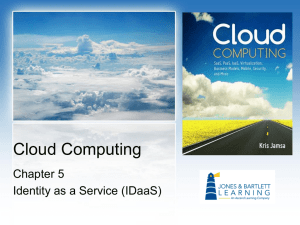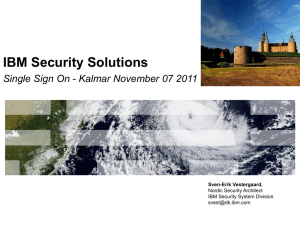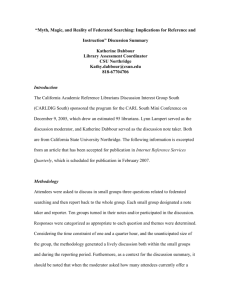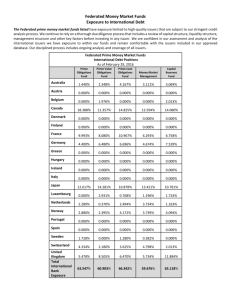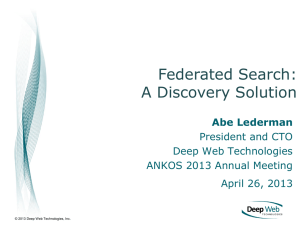Federated Identity Management - Seidenberg School of Computer
advertisement
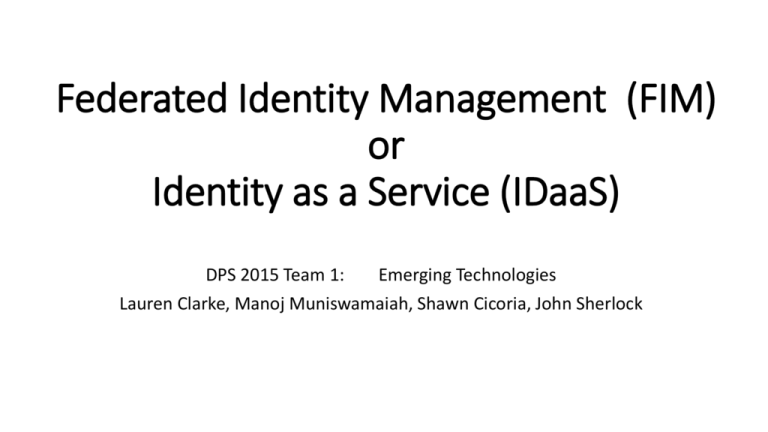
Federated Identity Management (FIM)
or
Identity as a Service (IDaaS)
DPS 2015 Team 1:
Emerging Technologies
Lauren Clarke, Manoj Muniswamaiah, Shawn Cicoria, John Sherlock
Presentation Outline
1.
2.
3.
4.
5.
6.
7.
8.
Research Problem
Terms Defined
Background
Benefits/Risks
Current Status (Solutions, Stakeholders, Servicers)
Barriers to Success (the Trust Factor)
Research Extensions
Class Discussion
Shawn
Shawn
Shawn/Manoj
Lauren
John
John
John
Research Problem / Question…
Is there an approach to Federated Identity Management (FIM)
or IDaaS (Identity as a Service)
that both providers of capabilities and consumers trust enough
i.e. will a bank (or a Government agency) ever use an external identity provider
to allow consumers to interact, transact, or bank online?
• Acceptance test - "I can use my Facebook ID to logon to my bank"….
• Sub Problems
• How does this impact the "Internet of things/everything?“
• Trust and concerns
• Commercial
• Consumer
• Government
Challenges with Federated Identity Adoption Amongst Users and Organizations
IDaaS (aka ‘Federated Identity’) has been developed using proven
solutions based on technologically sound methods and components
• A number of studies have demonstrated that technology is sound
• Efforts toward far-reaching adaption have been well funded by governments
• Government and industry have expressed a desire and a willingness to
integrate IDaaS solutions into their offerings
The problem, and therefore, the research opportunity:
•
•
•
•
Consumers are slow to adapt IDaaS services into their online/cloud usage
There appears to be a low level of trust in the IdP’s (Identity Providers)
Lack of truly ubiquitous solutions appears to be contributing to slow adaption
What is causing this slow adaption of IDaaS globally?
DEFINITION OF TERMS
Defining Identity Management (the Terms)
• IAM (Identity and Access Management), i.e. Identity Provisioning
• Identification
• Authentication
• FIM: Federated Identity Management
• IDaaS (*)
• Web-centric SaaS (for use within cloud-based applications), typically for B2B apps
• Cloud-delivered legacy IDM services, typically for B2C apps
• eID and eIDM: the European IDaaS Initative
• IdP: Identity Provider (aka Asserting/Assuring Party)
• Open Standards
• SAML
• OAuth
(*) “Understanding IDaaS: Benefits and Risks” http://searchcloudsecurity.techtarget.com/feature/Understanding-IDaaS-Thebenefits-and-risks-of-Identity-as-a-Service
BACKGROUND – THE TECHNOLOGY
FIM/IDaaS: The Technology
• The Protocols
•
•
•
•
SAML (Security Assertion Markup Language) http://en.wikipedia.org/wiki/SAML
WS-Federation ('Web Services' - http://en.wikipedia.org/wiki/WS-Federation)
OAuth 1.0 & 2.0 - Open Auth http://en.wikipedia.org/wiki/OAuth
Kerberos - MIT (used in Enterprise applications - rarely done cross-commercial
organization)
• Products Available
•
•
•
•
•
•
http://shibboleth.net/
AD FS (Microsoft) & Windows Azure AD (Cloud based)
Ping Federate
Oracle (Sun)
IBM
CA (Siteminder)
Federated Logon Example
Bearer Token Based
• The OAuth 2.0 Authorization Framework: Bearer Token Usage https://tools.ietf.org/html/rfc6750
• Bearer Token : http://pic.dhe.ibm.com/infocenter/wdpxc/v2r0/index.jsp?topic=%2Fcom.ibm.websphere.help.glossary.doc%2Ftopics%2Fglossary.html
OAuth example
OAuth Flow
http://tutorials.jenkov.com/oauth2/index.html
http://tungwaiyip.info/blog/2011/02/19/facebook_oauth_authentication_flow
SAML 2.0 – Web SSO Protocol
Implementing SAML 2.0 Web Browser SSO for Google Apps
http://www.juniper.net/techpubs/en_US/sa8.0/topics/example/example-simple/secure-access-samlcloud-googleapps.html
https://en.wikipedia.org/wiki/SAML_2.0
Progressive Authentication
http://www.equifax.com/technology_analytics/anakam/documentation/anakam_progressi
ve_authentication_brochure.pdf
http://www.himssanalytics.org/uploads/product/whitepaper/63D0712307954ED38B75FE1
F5FB84BB5.pdf
eID via IDP (IDentity Provider) (*)
(*) “Cloud-Based Identity Attribute Service with Privacy Protection in Cyberspace“ Xiang Zou, Bing Chen, Bo Jin, 2012 International Workshop on
Information and Electronics Engineering (IWIEE), Procedia Engineering 29 (2012) p.1160 – 1164
http://www.sciencedirect.com/science/article/pii/S1877705812001154
eID via IDP (IDentity Provider): Framework (*)
(*) “Cloud-Based Identity Attribute Service with Privacy Protection in Cyberspace“ Xiang Zou, Bing Chen, Bo Jin, 2012 International Workshop on
Information and Electronics Engineering (IWIEE), Procedia Engineering 29 (2012) p.1160 – 1164
http://www.sciencedirect.com/science/article/pii/S1877705812001154
Application ID Request
(Service Provider vs. Identity Provider)
(*)
(*) “CSC White Paper: “Identity Federation Concepts”
http://assets1.csc.com/cybersecurity/downloads/FIM_White_Paper_Identity_Federation_Concepts.pdf
SSO
(Traditional vs. Federated)
(*)
(*) “CSC White Paper: “Identity Federation Concepts”
http://assets1.csc.com/cybersecurity/downloads/FIM_White_Paper_Identity_Federation_Concepts.pdf
SSO: Single SignOn
(Internal vs. External)
(*)
(*) “The Primer: Nuts and Bolts of Federated Identity Management” https://www.pingidentity.com/support-anddownloads/download.cfm/The%20Primer:%20Nuts%20and%20Bolts%20of%20Federated%20Identity%20Management?item=6604
SAML 2.0 vs. SW-Federation (*)
(*) “CSC White Paper: “Identity Federation Concepts” http://assets1.csc.com/cybersecurity/downloads/FIM_White_Paper_Identity_Federation_Concepts.pdf
BENEFITS AND RISKS
Benefits
• Single Sign-On (SSO) – a user is prompted to authenticate once and allowed access to multiple systems
for which he/she is authorized. This may be internally as well as across organization domains.
• Cost Reduction
₋ Aetna in conjunction with NaviMedix function as IdPs in a federated system to manage the billing
of medical practices (*)
₋ The elimination of redundant user administration systems
• Effective use of resources
₋ InCommon and NIH collaborate as IdPs and SPs to allow access for information sharing between
the medical research laboratories and medical schools(*)
(*)S. Landau and T. Moore, “Economic tussles in federated identity management,” First Monday, vol. 17, no. 10, pp. 1–20, 2012
Risks
• Trust (*)
₋ trustworthiness of the user
₋ service provider and identity provider’s inability to prevent Man in the middle attacks
which lead to theft of user’s identity
₋ trustworthiness of the IDPs and SPs
• Security (*)
₋ logic flaws from browser relayed messages (browser)
₋ insecure channel (network)
• Liability(**)
₋ Who is responsible when something goes wrong?
(*) E. Ghazizadeh, M. Zamani, A. Pashang and J. A. Manan, “A survey on security issues of federated identity in the cloud
computing, 2012 IEEE, pp. 562–565, 2012
(**) S. Landau and T. Moore, “Economic tussles in federated identity management,” First Monday, vol. 17, no. 10, pp. 1–20, 2012
CURRENT STATUS
FIM/IDaaS: Current Status
• The Actors
• The Government
• Private Industry
• Who are the leaders, charting the way?
•
•
•
•
•
Microsoft
Ping Federate
Oracle (Sun)
IBM
CA
• How much should the government be involved?
• In the design
• In the implementation
• In the control and monitoring
Review of Europe’s Efforts in the eIDM Area
• The EU has had a number of eIDM initiatives since 1995
• Cross-border requirements are incremental challenges for the EU
• To date, the EU eIDM framework has been based on the interoperability of
eSignatures
• Lack of EU-wide legal framework resulted in difficulty in defining actor
responsibilities and liabilities. (*)
• This has results in a degree of “subsidiarity” amongst the member nations: each
member nation maintaining its autonomy and responsibility. (**)
• There was a reasonable level of trust in the overall solution in the UK, with
ease of use scoring the highest as a key user requirement (***) … but
• 50% left the site once reaching the hub page (the sign-up page)
• 25% left the site once reaching the consent page
• 34% of test users felt threatened rather than reassured by the privacy statement
(*) “eID for Europe: Moving from Problems to Solutions http://www.jiclt.com/index.php/jiclt/article/viewFile/179/177
(**) “Federated Identity to Access eGovernment Services – Are Citizens Ready for This? DIM’13 11/8/13
(***) “Is Europe Ready for a Pan-European IDM?” IEEE July/August 2012
BARRIERS TO SUCCESS
Issues Holding Back FIM/IDaaS
• What exactly constitutes one’s identity?
• Who creates a person’s eID and managed it?
• Who will manage/regulate the links between the identities?
• How is the integrity/reliability/privacy of the identity ensured?
Who will stand behind this guarantee?
Globally, there is a consensus that new research would be
needed to coordinate existing knowledge and know-how
(which is already available to a significant extent) into a
coherent vision. (*)
(*) “eID Infrastructure for Trustworthy Services in eGovernment and eCommerce” 2012 http://world-comp.org/p2012/SAM9717.pdf
RESEARCH EXTENSIONS
Research Extensions
• There already exist may conceptual models which ‘prove’ that:
There is a need for a unified solution to these IDM problems
Available technological solutions would work in today’s
eCommerce environments
• Questions which still need to be answered:
Who should ‘own’ (i.e. regulate) the solution?
What would it take to raise consumers’ confidence in any
solution (win them over)?
What is the model for user recourse if the solution breaks
(who is liable)?
CLASS DISCUSSION
